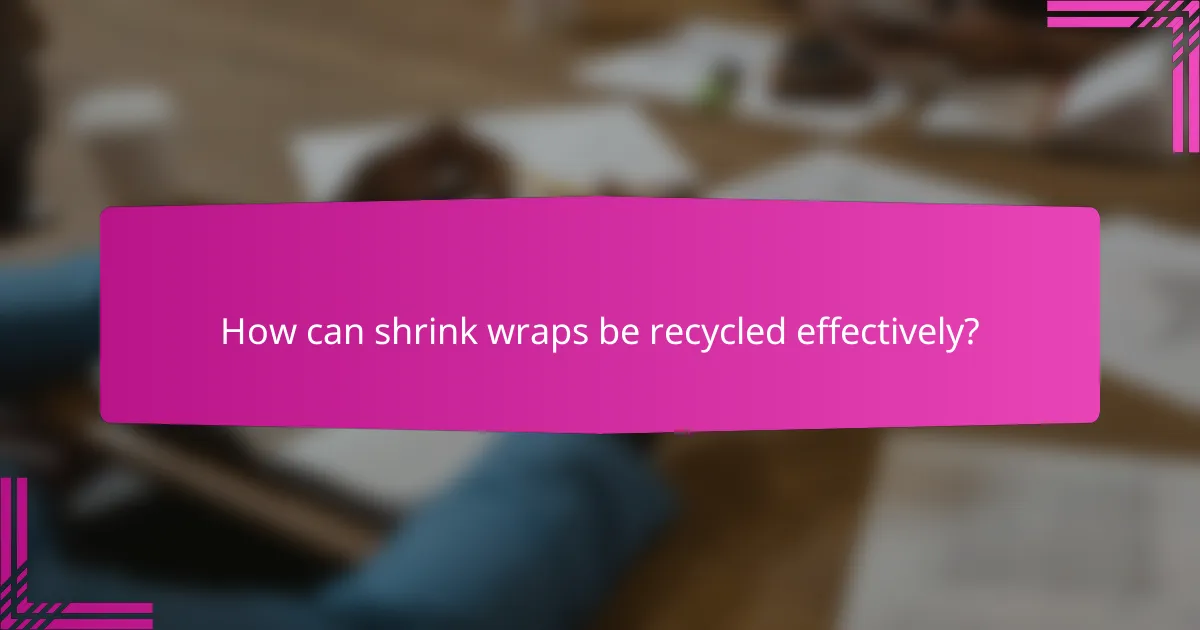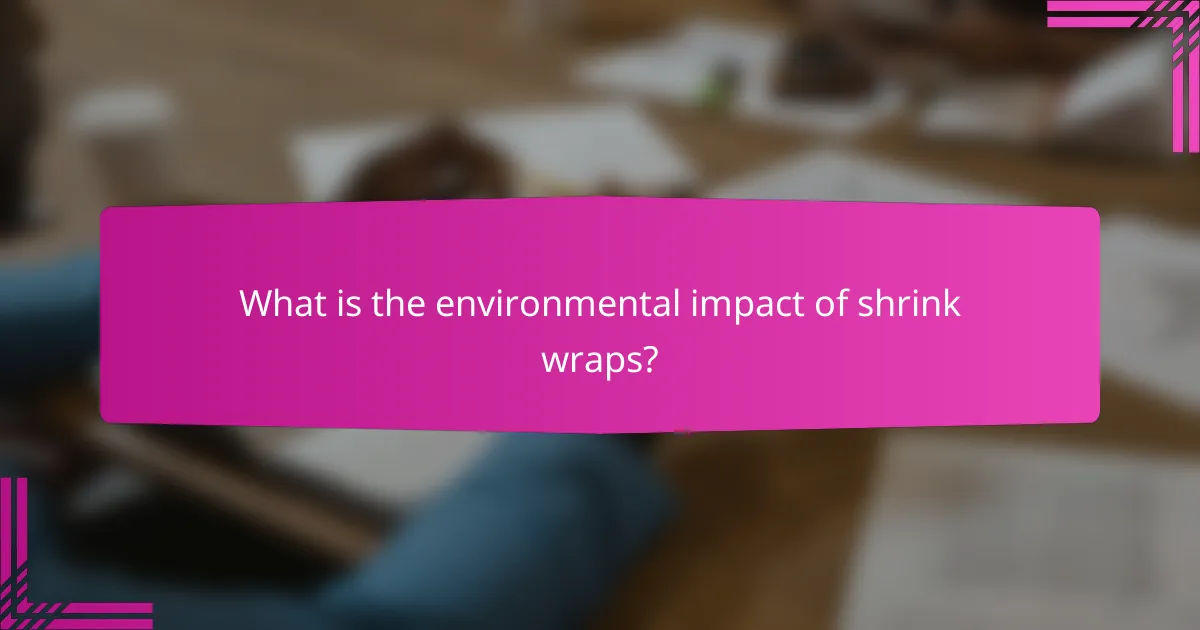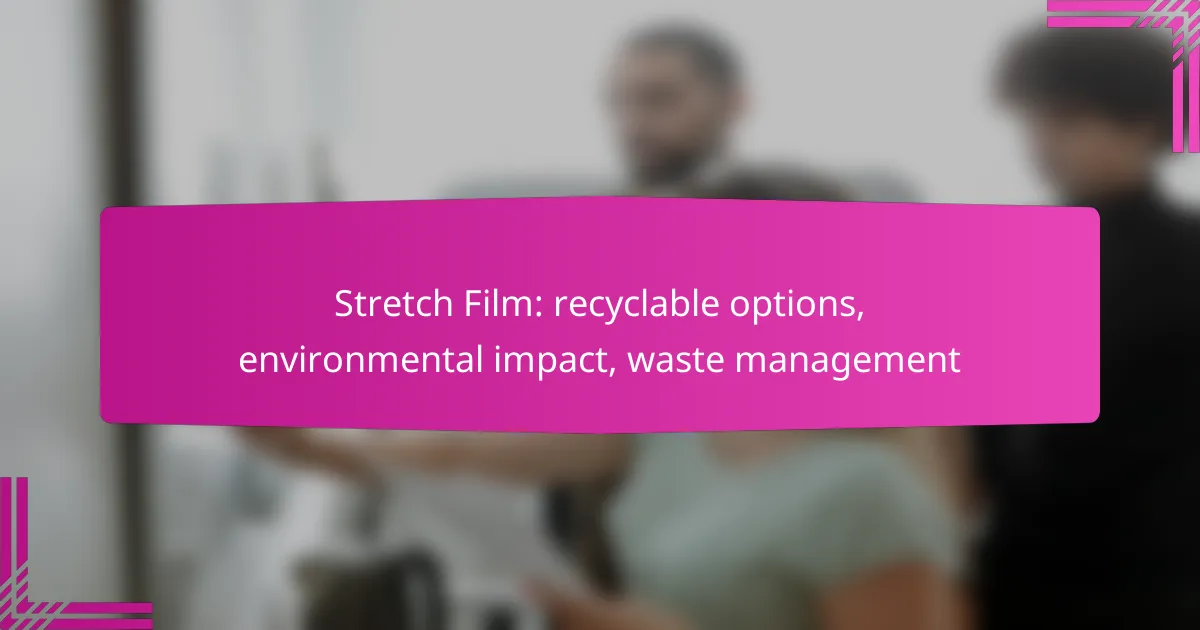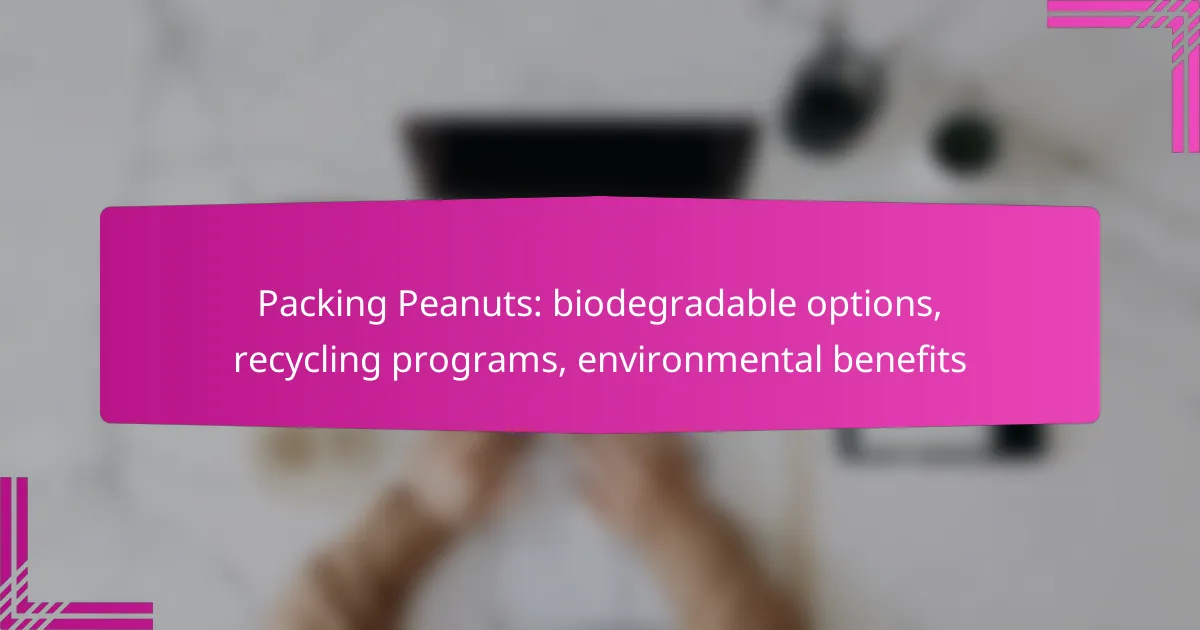Shrink wraps, commonly used for packaging, pose significant environmental challenges due to plastic pollution and carbon emissions. However, alternatives such as biodegradable films, reusable packaging, and plant-based plastics offer sustainable solutions that minimize ecological impact. Additionally, proper recycling practices can help mitigate the negative effects of shrink wraps, emphasizing the importance of responsible disposal and awareness of recycling resources.

What are the best alternatives to shrink wraps in New Zealand?
In New Zealand, the best alternatives to shrink wraps include biodegradable films, reusable packaging solutions, paper-based wraps, plant-based plastics, and glass containers. These options provide sustainable packaging solutions that reduce environmental impact while maintaining product integrity.
Biodegradable films
Biodegradable films are made from natural materials that break down over time, making them an eco-friendly alternative to traditional shrink wraps. They are suitable for various applications, including food packaging, and can decompose in composting environments within months.
When choosing biodegradable films, look for certifications that ensure they meet compostability standards, such as AS 4736 in New Zealand. This ensures that the films will break down effectively without leaving harmful residues.
Reusable packaging solutions
Reusable packaging solutions, such as containers and bags, can significantly reduce waste associated with single-use shrink wraps. By investing in durable packaging, businesses and consumers can minimize their environmental footprint while saving money in the long run.
Consider options like silicone food storage bags or sturdy plastic containers that can be washed and reused multiple times. These solutions are particularly effective for food storage and shipping, as they provide excellent protection without generating waste.
Paper-based wraps
Paper-based wraps are a versatile alternative to shrink wraps, often used for wrapping gifts or food items. They are biodegradable and can be recycled, making them a more sustainable choice for packaging.
When selecting paper-based wraps, opt for uncoated or recycled paper to ensure they are environmentally friendly. Additionally, consider using natural adhesives or twine for securing the wraps, which further enhances their sustainability.
Plant-based plastics
Plant-based plastics, derived from renewable resources like cornstarch or sugarcane, serve as a sustainable alternative to conventional plastics. These materials can be used for various packaging applications, including food containers and films.
While plant-based plastics can reduce reliance on fossil fuels, it’s essential to check their compostability and recycling options, as not all plant-based plastics are created equal. Look for products that are certified compostable to ensure they break down effectively in appropriate conditions.
Glass containers
Glass containers are a highly sustainable alternative to shrink wraps, offering excellent protection for food and other products. They are reusable, recyclable, and do not leach harmful chemicals, making them a safe choice for packaging.
Investing in glass containers can be cost-effective over time, as they can last for years with proper care. Consider using glass jars for food storage or shipping, as they provide a durable and environmentally friendly option that reduces plastic waste.

How can shrink wraps be recycled effectively?
Shrink wraps can be recycled effectively by following specific guidelines and utilizing available resources. Proper sorting and cleaning of the material are essential, as is knowing where to take it for recycling.
Local recycling programs
Many municipalities have local recycling programs that accept plastic films, including shrink wraps. Check with your local waste management authority to find out if they have designated drop-off locations or curbside collection options for plastic wraps.
Some areas may offer educational resources on how to prepare shrink wraps for recycling, such as ensuring they are free from food residue and other contaminants.
Specialized recycling facilities
Specialized recycling facilities often handle materials like shrink wraps that are not accepted in standard curbside recycling programs. These facilities use advanced technologies to process plastic films and convert them into reusable materials.
Research facilities in your region that focus on plastic recycling, as they may have specific requirements for accepting shrink wraps, such as minimum quantities or specific types of plastic.
Collection points for plastic wraps
Collection points for plastic wraps are often found at grocery stores or retail locations that participate in recycling initiatives. These points typically accept various types of plastic films, including shrink wraps.
Before visiting a collection point, verify what types of plastic they accept and ensure that the shrink wraps are clean and dry. This helps improve the chances of successful recycling and reduces contamination in the recycling stream.

What is the environmental impact of shrink wraps?
Shrink wraps significantly contribute to environmental issues, primarily through plastic pollution and carbon emissions. Their production and disposal can harm ecosystems and wildlife, making it essential to understand their broader impact.
Plastic pollution statistics
Plastic waste, including shrink wraps, accounts for a substantial portion of global pollution. It is estimated that millions of tons of plastic enter oceans each year, with single-use plastics like shrink wraps being a major contributor. In many regions, plastic packaging constitutes a significant percentage of municipal solid waste, often exceeding 30%.
Efforts to reduce plastic waste have led to initiatives like bans on single-use plastics in various countries. However, the effectiveness of these measures varies, and many areas still struggle with high levels of plastic pollution.
Carbon footprint analysis
The production of shrink wraps generates a considerable carbon footprint, primarily due to the extraction and processing of fossil fuels. Estimates suggest that the lifecycle emissions of plastic packaging can be in the range of 1.5 to 3.0 kg of CO2 equivalent per kilogram of plastic produced.
Reducing the carbon impact of shrink wraps can involve using alternative materials or implementing recycling programs. Transitioning to biodegradable options may also lower emissions, but these alternatives often come with their own environmental considerations.
Impact on marine life
Shrink wraps pose a significant threat to marine life, as they can break down into microplastics that are ingested by marine organisms. This ingestion can lead to health issues for wildlife and disrupt entire ecosystems. Studies indicate that a substantial number of marine animals, including fish and seabirds, are affected by plastic pollution.
Efforts to mitigate this impact include increasing public awareness and promoting responsible disposal practices. Supporting organizations that focus on ocean cleanup and wildlife protection can also contribute to reducing the negative effects of plastic waste on marine environments.

What criteria should be considered when choosing shrink wrap alternatives?
When selecting alternatives to shrink wrap, consider factors such as material sustainability, cost-effectiveness, and durability. These criteria help ensure that the chosen option meets environmental standards while providing adequate protection for products.
Material sustainability
Material sustainability focuses on the environmental impact of the materials used in packaging. Options like biodegradable films, recycled paper, or plant-based plastics can significantly reduce waste compared to traditional plastic shrink wraps. Look for certifications like compostability or recyclability to ensure the materials align with sustainability goals.
Additionally, consider the sourcing of materials. Locally sourced options can lower transportation emissions and support regional economies. Always check for eco-labels that indicate responsible production practices.
Cost-effectiveness
Cost-effectiveness involves evaluating the price of alternative materials against their performance and longevity. While some sustainable options may have a higher upfront cost, they can lead to savings in waste disposal and compliance with regulations over time. Analyze the total cost of ownership rather than just the purchase price.
It’s beneficial to compare bulk purchasing options or long-term contracts with suppliers to reduce costs. Consider the potential for reduced labor costs if the alternative is easier to apply or remove than traditional shrink wrap.
Durability and protection
Durability and protection are critical when choosing packaging materials. Alternatives should provide similar or better protection against moisture, dust, and physical damage. Evaluate the performance of materials under various conditions, such as temperature fluctuations and exposure to UV light.
Conduct tests or request samples to assess how well alternatives hold up during shipping and storage. This ensures that products remain intact and undamaged, ultimately preserving customer satisfaction and reducing returns.

How do shrink wraps compare to other packaging options?
Shrink wraps are a popular packaging choice due to their ability to tightly conform to products, providing protection and visibility. However, they may not always be the most sustainable option when compared to alternatives like biodegradable materials or reusable packaging solutions.
Cost comparison with biodegradable options
Biodegradable packaging options often have a higher upfront cost compared to traditional shrink wraps. However, as production methods improve and demand increases, prices for biodegradable materials are gradually decreasing. Businesses should consider the long-term savings from reduced waste disposal costs and potential tax incentives for using eco-friendly packaging.
For example, while a roll of shrink wrap might cost around $50 for 1,000 square feet, biodegradable alternatives can range from $60 to $100 for the same amount, depending on the material and supplier.
Performance analysis against reusable packaging
Shrink wraps provide a secure seal that protects products during transport, but they are single-use and contribute to waste. In contrast, reusable packaging options, such as containers or crates, can be used multiple times, reducing overall material consumption. However, the initial investment in reusable packaging can be higher.
When evaluating performance, consider factors like the product’s fragility, the distance of transport, and the likelihood of return for reusable items. For instance, if products are frequently shipped over long distances, investing in durable reusable packaging may yield better long-term benefits.
Environmental benefits of alternatives
Alternatives to shrink wraps, such as biodegradable or reusable packaging, offer significant environmental benefits. Biodegradable materials break down more quickly in landfills, reducing the long-term impact on the environment. Reusable packaging minimizes waste generation and encourages a circular economy.
Additionally, many biodegradable options are made from renewable resources, which can lower carbon footprints compared to petroleum-based shrink wraps. Businesses should assess their packaging choices not only for cost but also for their overall environmental impact and alignment with sustainability goals.



